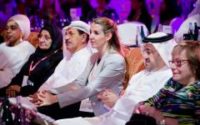Data is Crucial to Good Government Policies
We could be about to see the day that big data makes a bid to be displayed at The Louvre. For that is what one of the eye-catching events being held at this year’s WGS for the first time is aiming for: the transformation of data into art.
The World Data Visualization Prize – the result of a partnership between data visualization experts, “Information is Beautiful”, and WGS – is asking for data visual artists across the planet to turn otherwise inane numbers and big data sets into beautiful works of art that engage, educate and enlighten how governments are improving citizens’ lives, as well as bringing to light the innovations that drive and measure success in citizen wellbeing.
His Excellency Omar Sultan Al Olama, Managing Director of the World Government Summit, said data constitutes a future wealth and a key resource for countries and governments in its ability to create opportunities and boost development. He highlighted accurate data as a vital factor in informed decision making for leaders in different sectors.
“The award represents a unique opportunity for innovators from across the world to present their data visualization creations in various sectors. These works that transform data into easily grasped graphics enable decision makers to design services and programs that impact the lives of individuals positively”, he said.
Over 200 submissions have been sent in from 29 countries, into one of three categories: The Future of Government, What Makes a Good Government, and Small Countries are Beautiful. The focus for each category focuses on how governments are improving the lives of citizens, as is consistent with the overarching theme of the summit this year. The prizes amount to US$40,000, where the first-place winner will take away US$25,000, and the rest will be distributed among the second place and third place winners.
Award entries were received from counties around the world, including United Kingdom, Netherlands, Egypt, Latvia, Oman, Brazil, France, India, United States, Singapore, New Zealand, Romania, Poland, Turkey, Sweden, Hungary, Australia, Philippines, Belgium, Mexico, Greece, Ireland, Pakistan, South Africa, Croatia, Indonesia, Spain, Ecuador, and UAE.
The main aim of the World Data Visualization Prize is to present people with an easier and more accessible way to understand the data that effects them in their everyday lives.
In 2018, human beings were producing a staggering 2.5 quintillion bytes of data every day, according to a Forbes report. And, as technologies continue to progress unabated, that number is only going to rise. In an era when vast amounts of data surrounds us every day, the need to bring clarity to the figures – whether through visual or verbal communication – is ever more important.
The core objective of the World Data Visualization Prize is therefore an important one. Set up to help governments better inform citizens and turn crucial sets of data into accessible and understandable art forms may not be the stuff of Picasso or Dali, but it may just be the next artistic revolution that will enable policy and decision makers to make sense of the jungle of data around us.
For each data set category, the organizers are looking for unique tailored content to meet with pressing public policy making data.
“The Future of Government” category is looking for the factors and technologies that might shape society, government and even citizens of the future. While the “What Makes a Good Government” category is seeking a way to measure the success of a government or society. And finally, the “Small Countries are Beautiful” category was given the following description: “Smaller nations (less than 5 million population) are often overshadowed in the stats. But where might be such countries innovating, growing or teaching us?”
The World Government Summit 2019 will run from February 10 to 12 at Madinat Jumeirah in Dubai. The landmark event is set to convene more than 4,000 participants from 140 countries, including heads of state and governments, as well as top-tier representatives of 30 international organizations.






